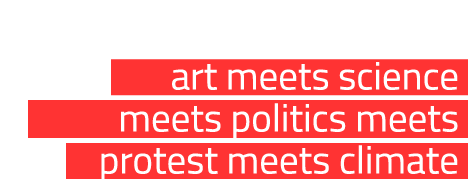SAVE THE WORLD: an artistic format for staging issues relating to the world’s future together with representatives from the world of art, science and government. In the process, SAVE THE WORLD combines scientific expertise with artistic spectacle. In this way, in collaboration with the international organizations and think-tanks based in the city, such as the Bundeszentrale für politische Bildung (bpb, Federal Agency for Civic Education), the Deutsches Institut für Entwicklungspolitik (DIE, German Development Institute), the Zentrum für Entwicklungsforschung (ZEF, Center for Development Research), Germanwatch, the United Nations, and many more besides, we create innovative thought and action spaces. The concentration of multilateral activities in Bonn, which is unique Europe-wide, serves the organizers as a basis for getting citizens, artists, and scientific experts into a fruitful dialogue. Thus SAVE THE WORLD as a creative translation instance gives rise to new formats for scientific communication, making complex topics accessible to a broad public.
‘Can the world still be saved?’ In view of the scheduled end of the ‘millennium goals’, this was the point of departure for the interdisciplinary festival SAVE THE WORLD, which was held for the first time in 2014 at the Theatre Workshops in Bonn-Beuel. Here, artists and experts joined up in teams and, using for example video installations, lecture performances and sound collages, enabled visitors to experience complex facts. Taking their cue from Samuel Beckett’s apocalyptic play ‘Endgame’, for example, Jakob Rhyner, the vice-rector of the UN University, and stage director Patrick Wengenroth illustrated how we are overwhelmed in the face of manmade disasters, while at a lavish supper ZEF expert Detlef Virchow and director Judith Wilske demonstrated the causes of world hunger and DIE-director Dirk Messner and performance artist Lukas Matthaei used a board game to explore the destructive egoism of homo oeconomicus.
To mark the 2015 World Climate Conference, SAVE THE WORLD II was devoted entirely to climate change. Visitors were able to get hands-on experience of the consequences of current climate policy; they were shown the first prototype of a CO2 absorber by the spokesman of the Climate Secretariat Nick Nuttall and the filmmaker Claudia Lehmann, and given a musical send-off by pop-poet Peter Licht and Germanwatch general secretary Christoph Bals with a swan-song for endless growth.
In 2016 SAVE THE WORLD III focused on young ‘world saviours’ and especially for this purpose developed the format YOUNG PLANET. Under the guidance of the artists and experts, young people grappled with topics like mobility, resource efficiency, and modern urban development, and worked out their own projects, which were presented to the public in a concluding ‘knowledge show’ on stage.
Based on our motto “protecting the climate creatively “, SAVE THE WORLD IV left the theatrical stage of the theatre to occupy, together with artists, experts and activists, the geopolitical stage around the UN campus in Bonn. For the fourth edition SAVE THE WORLD charmingly used three different types of protest culture: For the opening of the climate conference (COP 23) the musician Bernadette La Hengst together with the Theater Bonn Children’s and Youth Choir, the young Climate Ambassadors Bonn and the Beethoven Orchestra has created the probably most charming protest song of the last decade. As the official contribution of the city of Bonn, the song I’M AN ISLAND welcomed climate protagonists from the worlds of politics and science. The song became the center of the nationwide campaign for COP23 of the German Federal Ministry for Economic Cooperation and Development (BMZ) and reached more than 2 million clicks on the internet (www.i-am-an-island.de).
The heroes of the subversive protest movement “The Yes Men”, amazed the experts at the Crossroads Conference of the German Development Institute as representatives of the United States Environmental Protection Agency with their idiosyncratic business idea ‘RefuGreenErgy‘. With a great deal of wit and imagination, they have committed themselves to a better world, nonchalantly inventing a new culture of protest.
As a further highlight, the British artists’ collective Stan’s Cafe staged WHAT WHEN: a forest of signs with a multitude of slogans from environmental campaigns past and present. As experts in the visualization of socio-political associations, they showed a unique kaleidoscope of the obstinate commitment of activist groups, think tanks, and NGOs to a better world.
